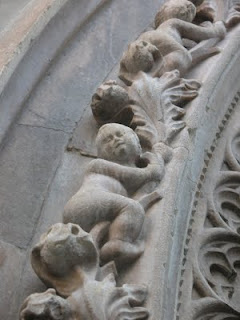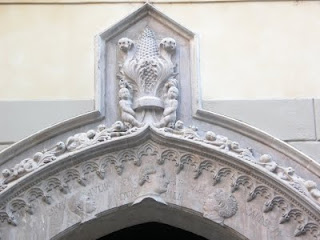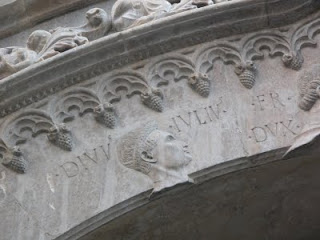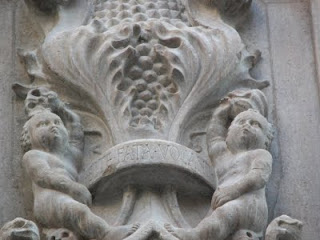 Us bookworms get excited about the oddest things, I admit. But let's leave that aside, for the moment, and let me set the stage, properly....More......
Us bookworms get excited about the oddest things, I admit. But let's leave that aside, for the moment, and let me set the stage, properly....More......The fearful self-isolation then death (1447) of the last legitimate duke of Milan, Filippo Maria Visconti, followed by bloody settlings of old festering wounds, bursts of rage, backstage back-stabbings, burning archives (oddly, the tax records, too...), the ducal castle-fortress (useful to defend the city against invaders, but also to defend the dukes against the citizens) half torn down, a couple of years of brilliant hopes for citizens' self-government (well, the male, free, white and empowered, although not noble, but that's already a step ahead), then trembling and anguish at the prospect of getting gobbled up by feared powers-that-be. Appearing on the horizon, literally in shining armor, whom do we have? Good ol' Frank.
 Francesco Sforza, expert general-for-hire (ahem, they're politely called "condottieri"), who just happens to be married to Bianca Visconti, the young and lovely bastard-but-legitimized-by-the-pope daughter and only direct heir (but not to overt power, no, no, no, Salic Law, you know) of dear deceased Filippo.
Francesco Sforza, expert general-for-hire (ahem, they're politely called "condottieri"), who just happens to be married to Bianca Visconti, the young and lovely bastard-but-legitimized-by-the-pope daughter and only direct heir (but not to overt power, no, no, no, Salic Law, you know) of dear deceased Filippo."I'll save you!," says Francesco. (He did.)
"I won't rebuild the castle-fortress!" (He did, actually, but had his imported fancy-pants architect, Filarete, beautify it a bit in the new Florentine Renaissance style to soften the blow.)
"In exchange, I'll be the duke!" (He wasn't...legally...one of his sons finally pulled that off a couple of decades and tons o' money to the Holy Roman Emperor, later, but it's just a piece of paper, right?)
And one of his right hand men was Gaspare Vimercati, whom you also have to thank for Santa Maria delle Grazie (where, about fifty years later, Leonardo da Vinci painted The Last Supper), another condottiere, and the proud new owner--after it had been confiscated by Sforza from its original owners (evidently of the Taverna and Secco d'Aragona families, as the family crests flanking the door attest)--of the house on the street, where the first ring of ancient Roman walls had gone, long before: via Filodrammatici, n. 1.
 The gorgeous doorway from that mid-15th century period opens this message. The pointed arch and the florets help mark it as Gothic. The chubby putti climbing whimsically up the acanthus leaves along its profile could be seen as a concession to the new Florentine style and/or as Gothic, yes, Gothic...there was quite a strain of naturalism running through the Gothic style, believe it, or not.
The gorgeous doorway from that mid-15th century period opens this message. The pointed arch and the florets help mark it as Gothic. The chubby putti climbing whimsically up the acanthus leaves along its profile could be seen as a concession to the new Florentine style and/or as Gothic, yes, Gothic...there was quite a strain of naturalism running through the Gothic style, believe it, or not.And, luck of the (non) Irish, it has been cleaned, recently, yeah! (It was so black with accumulated grime and soot that those old photos of mine aren't even worth hunting up.)
So that's already a jump for joy.
 What really made this little bookworm happy is that the photos I snapped of the epigraphy (the carved writing) came out really really well, double yeah! Francesco is flanked by and towers over...
What really made this little bookworm happy is that the photos I snapped of the epigraphy (the carved writing) came out really really well, double yeah! Francesco is flanked by and towers over... ...Julius Caesar on the viewer's left and...
...Julius Caesar on the viewer's left and... ...Alexander the Great on the viewer's right (no boot-licking going on here, nope, nope).
...Alexander the Great on the viewer's right (no boot-licking going on here, nope, nope). Above it all, the pinnacle with the motto - SITE - FATA - VOCANT -...and for anyone familiar with epigraphy, you'll see change in the making...tall and slender straight V-cuts with abruptly stuck on serifs, sharply squeezed "Os", a tilted bar to the "As" and "N" and little diamond, or triangular, interpuncts at mid-line. Looking forward to the Renaissance revival of Imperial style lettering, but with a wistful backward glance to the Gothic style much beloved in Milan, cross-roads between north and south of the Alps.
Above it all, the pinnacle with the motto - SITE - FATA - VOCANT -...and for anyone familiar with epigraphy, you'll see change in the making...tall and slender straight V-cuts with abruptly stuck on serifs, sharply squeezed "Os", a tilted bar to the "As" and "N" and little diamond, or triangular, interpuncts at mid-line. Looking forward to the Renaissance revival of Imperial style lettering, but with a wistful backward glance to the Gothic style much beloved in Milan, cross-roads between north and south of the Alps.Oh, the things that get our little bookworm hearts a-pumping!
No comments:
Post a Comment